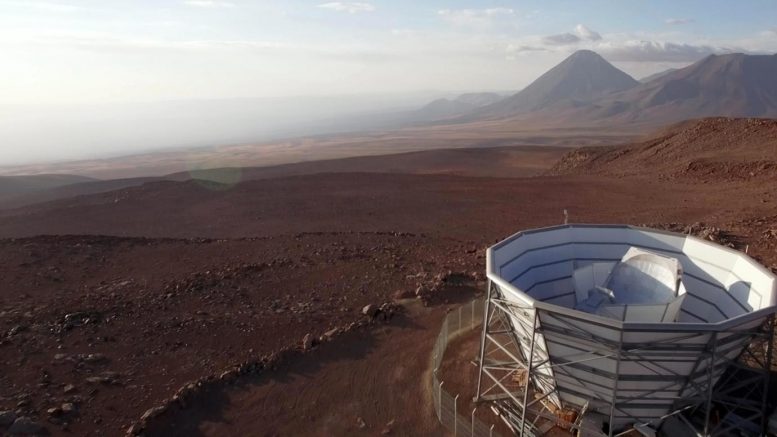
The Atacama Cosmology Telescope measures the oldest light in the universe, known as the cosmic microwave background. Using those measurements, scientists can calculate the universe’s age. Credit: Image courtesy of Debra Kellner
Atacama Cosmology Telescope findings suggest the universe is 13.8 billion years old.
From a mountain high in Chile’s Atacama Desert, astronomers with the National Science Foundation’s Atacama Cosmology Telescope have taken a fresh look at the oldest light in the universe. Their new observations, plus a bit of cosmic geometry, suggest that the universe is 13.77 billion years old, give or take 40 million years.
The new estimate matches the one provided by the standard model of the universe and measurements of the same light made by the Planck satellite, a space-based observatory that ran from 2009-2013.
This adds a fresh twist to an ongoing debate in the astrophysics community, said Simone Aiola, first author of one of two new papers on the findings posted July 15 to arXiv.org. The trouble is that research teams measuring the movements of galaxies have calculated that the universe is hundreds of millions of years younger than the Planck team predicted. That discrepancy suggested that a new model for the universe might be needed, and sparked concerns that one of the sets of measurements might be incorrect.
“Now we’ve come up with an answer where Planck and the Atacama Cosmology Telescope agree,” said Aiola, a researcher at the Flatiron Institute’s Center for Computational Astrophysics in New York City. “It speaks to the fact that these difficult measurements are reliable.”
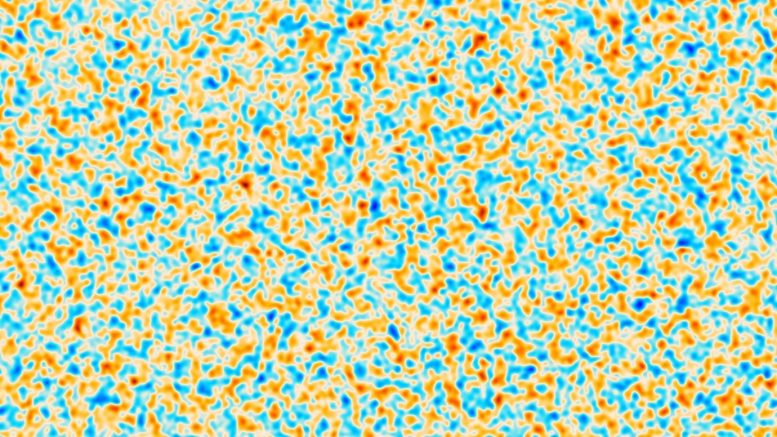
A portion of a new picture of the oldest light in the universe taken by the Atacama Cosmology Telescope. This part covers a section of the sky 50 times the moon’s width, representing a region of space 20 billion light-years across. The light, emitted just 380,000 years after the Big Bang, varies in polarization (represented here by redder or bluer colors). Astrophysicists used the spacing between these variations to calculate a new estimate for the universe’s age. Credit: Image courtesy of ACT Collaboration
The age of the universe also reveals how fast the cosmos is expanding, a number called the Hubble constant. The Atacama measurements suggest a Hubble constant of 67.6 kilometers (42 miles) per second per megaparsec. This result agrees almost exactly with the previous estimate of 67.4 by the Planck satellite team, but it’s slower than the 74 inferred from the measurements of galaxies.
“Making this independent measurement is really exciting because there’s a mystery in the field, and this helps us sharpen our understanding of that mystery,” said Jeff McMahon, an associate professor of astronomy and astrophysics at the University of Chicago who led the design of the detectors and other new technologies used to make this measurement. “This confirms the ongoing discrepancy. And we still have much more data to analyze, so this is just the beginning.”
The close agreement between the Atacama Cosmology Telescope and Planck results and the standard cosmological model is bittersweet, Aiola said: “It’s good to know that our model right now is robust, but it would have been nice to see a hint of something new.” Still, the disagreement with the 2019 study of the motions of galaxies maintains the possibility that unknown physics may be at play, he said.
Like the Planck satellite and its earthbound cousin the South Pole Telescope, the Atacama Telescope peers at the afterglow of the Big Bang. This light, known as the cosmic microwave background, or CMB, marks a time 380,000 years after the universe’s birth, when protons and electrons joined to form the first atoms. Before that time, the cosmos was opaque to light.
If scientists can estimate how far light from the CMB traveled to reach Earth, they can calculate the universe’s age. That’s easier said than done, though. Judging cosmic distances from Earth is hard. So instead, scientists measure the angle in the sky between two distant objects, with Earth and the two objects forming a cosmic triangle. If scientists also know the physical separation between those objects, they can use high school geometry to estimate the distance of the objects from Earth.
Subtle variations in the CMB’s glow offer anchor points to form the other two vertices of the triangle. Those variations in temperature and polarization resulted from quantum fluctuations in the early universe that got amplified by the expanding universe into regions of varying density. (The denser patches would go on to form galaxy clusters.) Scientists have a strong enough understanding of the universe’s early years to know that these variations in the CMB should typically be spaced out every billion light-years for temperature and half that for polarization. (For scale, our Milky Way galaxy is about 200,000 light-years in diameter.)
The Atacama Cosmology Telescope measured the CMB fluctuations with unprecedented resolution and sky coverage, taking a closer look at the polarization of the light. “The Planck satellite measured the same light, but by measuring its polarization in higher fidelity, the new picture from Atacama reveals more of the oldest patterns we’ve ever seen,” said Suzanne Staggs, the telescope’s principal investigator and the Henry deWolf Smyth Professor of Physics at Princeton University.
This measurement was possible thanks to new technology designed and built by McMahon’s team. “Basically, we figured out how to make the detectors measure two colors and to pack as many into each camera as possible,” McMahon said. “Then we developed new lenses out of metamaterials.” (Metamaterials are a type of material that’s engineered to produce properties that don’t exist naturally.)
From conception to deployment at the telescope to analysis, the process has spanned nearly 10 years, McMahon said. “Working with this amazing team to develop this project all the way from concept sketches to producing results at the forefront of cosmology, has been absolutely fantastic.”
Prof. Wendy Freedman explains a new method for measuring the expansion of the universe.
Sara Simon, now at Fermi National Accelerator Laboratory, made significant contributions to detector design; UChicago graduate student Joey Golec developed methods to fabricate the metamaterial optics; and UChicago graduate student Maya Mallaby-Kay is now working to make the datasets public.
As the Atacama Cosmology Telescope continues making observations, astronomers will have an even clearer picture of the CMB and a more exact idea of how long ago the cosmos began. The team will also scour those observations for signs of physics that doesn’t fit the standard cosmological model. Such strange physics could resolve the disagreement between the predictions of the age and expansion rate of the universe arising from the measurements of the CMB and the motions of galaxies.
“We’re continuing to observe half the sky from Chile with our telescope,” said Mark Devlin, the telescope’s deputy director and the Reese W. Flower Professor of Astronomy and Astrophysics at the University of Pennsylvania. “As the precision of both techniques increases, the pressure to resolve the conflict will only grow.”
“I didn’t have a particular preference for any specific value — it was going to be interesting one way or another,” said Cornell University’s Steve Choi, first author of the other paper posted to arXiv.org. “We find an expansion rate that is right on the estimate by the Planck satellite team. This gives us more confidence in measurements of the universe’s oldest light.”
References:
“The Atacama Cosmology Telescope: DR4 Maps and Cosmological Parameters” by Simone Aiola, et al., 14 July 2020, Journal of Cosmology and Astroparticle Physics.
DOI: 10.1088/1475-7516/2020/12/047
arXiv: 2007.07288
“The Atacama Cosmology Telescope: A Measurement of the Cosmic Microwave Background Power Spectra at 98 and 150 GHz” by Steve K. Choi, et al., 14 July 2020, Journal of Cosmology and Astroparticle Physics.
DOI: 10.1088/1475-7516/2020/12/045
arXiv: 2007.07289
The ACT team is an international collaboration, with scientists from 41 institutions in seven countries. The telescope is supported by the National Science Foundation and contributions from member institutions.


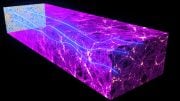
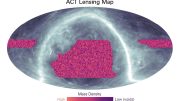
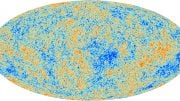

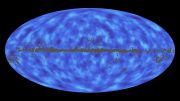
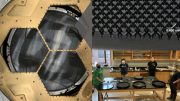
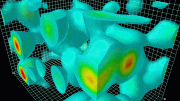
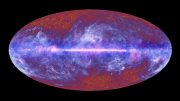
The math does not add up. If the observable universe has a radius of 45 billion light years and is only about 14 billion years old, said stars could not have had enough time to travel to the outside of that observable meridian. (not only that) if light travelling back is coming in at 67 KM per second not 300,000 km per second then those stars when formed giving off light would be travelling just slightly under the speed of light away from us. So all light from stars at great distances would only have this low speed light hitting our measurement equipment. The sky would be black.
The math adds up of course, else the work couldn’t be published after peer review.
Individual star or even galaxy movements do not come into the question since the universe is expanding and the expansion sum up to much higher apparent “velocities”, which I think Lance is reminding you. You seem to confuse the space expansion rate of ~ 70 km s^-1 Mpc^-1 (that is kilometers per second and per Megaparsec) with the universal speed limit that photons obey when traveling in vacuum of space of ~ 3*10^8 m s^-1. The local expansion rate, which we can’t see within our gravitationally cohesive Local Group of galaxies, is just 10^-10 parts per year, or 0.1 nm per meter and year. But it adds up!
What comes into the question is different rates of light propagation and space expansion while the cosmic background radiation photons travel here from all angles. (Those photons were not emitted by stars mind you. It was released by the then universal plasma at the moment it cooled to gas, cooling due to expansion, after the hot big bang but way before the first stars.)
It is complex to understand the details, also fascinating since at times the traveling photons came no closer to us due to space expansion being faster, but the result is simple. The observable universe is much larger than the travel time of the photons is in a static, not expanding universe. I quote Wikipedia on “Observable universe”:
“The observable universe is a spherical region of the universe comprising all matter that can be observed from Earth or its space-based telescopes and exploratory probes at the present time, because the electromagnetic radiation from these objects has had time to reach the Solar System and Earth since the beginning of the cosmological expansion.”
“According to calculations, the current comoving distance—proper distance, which takes into account that the universe has expanded since the light was emitted—to particles from which the cosmic microwave background radiation (CMBR) was emitted, which represents the radius of the visible universe, is about 14.0 billion parsecs (about 45.7 billion light-years …”
At the end though you are correct, the expanding universe cause our sky to be black instead of Sun hot wherever we look. The latter is called Olber’s paradox after the astronomer that first figured it out (but was forgotten since everyone though the universe was static*). The traveling photons get stretched by space expansion, which is why the cosmic background spectra which originally was nearly as hot as Sun’s surface or 3,000 K warm as black body spectra is now 3 K warm spectra** – it has been stretched 1,000 times or equivalently it has seen a redshift of z ~ 1,000 since it started its journey. (The most distant galaxies with stars are seen at redshift z ~ 10.)
* Turns out the universe can’t be static under general relativity physics, due to gravity it would be an unstable equilibrium at best and soon gone.
** People may worry about where the energy of the radiation field goes as it is diluted. But of course it goes nowhere, its density just goes down. And in the end, we now know from the cosmic background that space is perfectly flat, meaning it has to come out as zero energy density on average under general relativity describing its LCDM cosmology. The universe is therefore thermodynamic closed over large volumes – certainly larger than the Local Group I mentioned above – with positive and negative contributions (say, positive such as masses and negative such as gravity potentials) balancing each other.
Oops, If is say “also fascinating since at times the traveling photons came no closer to us due to space expansion being faster” (which I have to check, come to think about it), I also have to explain that the expansion rate varies over time. Look up “Scale factor (cosmology)” in Wikipedia for more detail.
Hoaxy – The math works if you do not forget that the 67 kms is per Megaparsec of distance, which you forgot to include.
🙂
Cool, I saw the preliminary paper a few weeks back* but I thought the result would wait a year or so!
Even better, they confirm Planck alone – and with independent TE, EE modes (basic Planck used TT and in 2018 also BB) – and improve on the integrated result in some senses (Planck was more precise).
On the recent expansion rate tension with mostly low-z data, the ACT starts out towards the median. The recent discovery that the H0 current expansion rate tension can be replaced by a CMB T0 current temperature tension is informative here: the ACT work do not extract the temperature, but they use observations of Uranus as beam calibration. The old WMAP used their beam as temperature calibration and it is that result that sits on the median of 70 km s^-1 Mpc^-1 So that supports the H0 T0 result.
I also twigged another source of measurement error from the paper. They note that a recalibrated and data added work on the H0LiCOW gravitational lensing low-z, high-H0 result resulted in a low-H0 result without resolving the mass density profile H0LiCOW model with “… our new analysis does not statistically invalidate the mass profile assumptions by H0LiCOW, …”. Meaning H0LiCOW method is not very sensitive yet.
I’m not sure measurement problems is the reason for the recent years spread, but each paper released in the area seems to accumulate evidence along those lines. I could see from the recent paper that the median H0 of 70 km s^-1 Mpc^-1 indeed do not suggest new physics, and from the figures it seems to me a H0 < 72 km s^-1 Mpc^-1 would give "same old, same old".
* Reference links not given, since this site do not like them.
“The Sloan Digital Sky Survey (SDSS) released today a comprehensive analysis of the largest three-dimensional map of the universe ever created, filling in the most significant gaps in our possible exploration of its history.”
[ https://phys.org/news/2020-07-astrophysicists-billion-years-universe-expansion.html ]
It agrees with and improves on the ACT results!
Actually astronomical ages of anything in the visible universe is mathematically calculable, here are a few examples of such calculations
AGE OF UNIVERSE – https://www.makersmakings.org/astronomical-age-of-universe/
AGE OF SUN – https://www.makersmakings.org/astronomical-age-of-sun/
AGE OF PLANETS – https://www.makersmakings.org/astronomical-ages-of-astrological-planets/
And so are the speeds of most celestial entities in the visible universe also mathematically calculable, but I would stop here or else this becomes too long.
In most cases, there is no need to use any hi-tech instruments, just basic mathematical knowledge, coupled with the knowledge of time is enough.